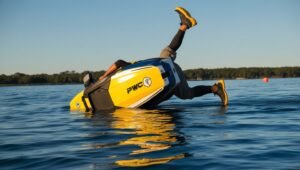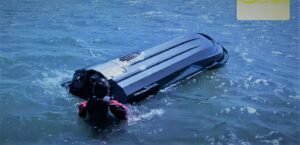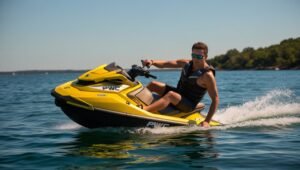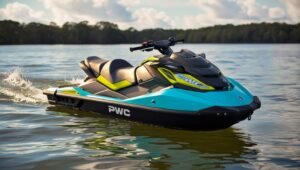
A PWC capsize. What is the best way to roll to straighten it?
While enjoying a thrill ride on a personal watercraft (PWC), encountering a capsize situation can be difficult. However, understanding the correct alignment procedure can not only ensure your safety but also prevent damage to your watercraft. In this comprehensive guide, we’ll detail the most effective techniques for rolling a capsized PWC and returning it to its upright position. Follow these steps to master the process and maintain your confidence in the water.

Understanding Capsizing
Personal watercraft are designed to be stable, yet certain conditions or maneuvers can lead to capping. Common causes include sharp turns, riding at high speeds, or encountering large waves. It’s important to know that PWCs are built with a specific method of repair, and following these guidelines will help you achieve this safely and effectively.
Primary Safety Measures
Before attempting to roll your PWC, it is very important to prioritize safety. Here are the initial steps you should take
1 KEEP CALM Panic can lead to poor decision-making. Take a moment to collect yourself and assess the situation.
2 Check passengers Make sure all passengers are safe and accounted for. If someone is in the water, make sure they are wearing a life jacket and can stay afloat.
3 Shut off the engine:** If the engine is still running, stop it to avoid accidental injury from moving parts.
Finding the role direction of the
Each PWC model has a specific orientation that returns it to the upright position. This information is usually found on a label on the back of the watercraft. It is important to follow the manufacturer’s instructions to avoid damaging the PWC. Spinning in the wrong direction can cause water to enter the engine, causing extensive damage.
Step-by-Step Guide to Rolling a / Correct your position
1 View from the rear Swim to the back of the PWC. This position allows you to use the design of the craft to your advantage.
2 Hold Reboarding Handles Most PWCs are equipped with handles or grips at the rear. Hold them tightly.
Perform the role
1Take a deep breath Hold your breath if you need to sink a little during the roll.
2Pull and Push Together Using the handles, pull one side toward you while pushing the other side. This movement will start the roll.
3 Maintain constant pressure:** Continue to apply constant pressure until the begins to roll over. Take your time with this process to avoid losing grip or balance.Fixing the
1 Roll in Correct Direction Make sure you are rolling in the direction indicated by the manufacturer. An arrow on the rear of the will often indicates this.
2 Complete the Roll Once the PWC starts moving, use your body weight to help complete the roll. This may require you to bend or use your legs for extra leverage.Reboarding the
After successfully fixing the PWC, the next step is to safely reboard it. Here is the method:
1 View from the rear
2 Use a reboarding step Many PWCs have a step or platform at the back to aid in reboarding. Use this feature to simplify the process.
3 Pull Yourself Up Grab the handles or grips and pull yourself up onto the platform. Use your legs to push against the water and lift yourself.
4 Climb Aboard Once on the platform, move into a kneeling position before standing up.To reduce the chances of capsizing in the future, consider the following tips:
1Follow Manufacturer’s Guidelines Follow the weight and passenger limits specified by the PWC manufacturer.
2 RIDE AT A SAFE SPEED Avoid excessive speed, especially in rough waters or when taking sharp turns.
3 Be aware of your surroundings Keep an eye on water conditions and other vessels to avoid sudden movements that could destabilize you.
4 Regular Maintenance Make sure you’re well maintained and in good working order. Regular testing can help identify potential problems before they become serious problems.Result
Rolling a capsized PWC and returning it to its upright position requires composure, proper technique, and following the manufacturer’s guidelines. By following the steps outlined in this guide, you can effectively manage PWC wrap conditions and continue to enjoy your time on the water. Always remember to prioritize safety and perform regular maintenance on your PWC to ensure it’s optimal

1 What is the first step to take when a PWC capsizes?
The first step is to ensure that all riders are safe and accounted for and to assess the condition of the PWC before attempting to right it.
2. How should you position yourself when trying to roll a capsized PWC upright?
Position yourself at the stern (rear) of the PWC, as this area provides better leverage when pushing down to roll the craft upright.
3 What technique should you use to roll the PWC upright?
Grasp the rear of the PWC and apply your weight on the opposite side while simultaneously pushing down on the stern. This will create a pivot point and help roll the PWC back to its upright position.
4 Is it safer to roll the PWC from the side or the front?
It is generally safer to roll the PWC from the side rather than the front, as rolling from the front can cause the watercraft to flip forward unexpectedly.
5 What should you do if the PWC is taking on water after being capsized?
Once the PWC is upright, you should immediately start bailing out any water using a bilge pump if available, or by tilting the craft to allow water to drain out.
6 Are there any specific safety precautions to consider when rolling?
Yes, ensure you have a life jacket on, be aware of your surroundings to avoid other watercraft, and make sure the engine is off to prevent any accidental starts while handling the PWC.
7 How can you prevent capsizing in the first place?
To prevent capsizing, maintain a low center of gravity by keeping your body positioned low on the seat, avoid sharp turns at high speeds, and be mindful of waves and other obstacles.
8 What should you do if you’re unable to roll the PWC back upright on your own?
If you cannot roll it upright, signal for help from other boaters or use a nearby vessel to assist you in righting the PWC.

A PWC overturns. How should I roll it to get it straight?
Having a capsize while having an exhilarating ride on a personal watercraft (PWC) might be challenging. Nonetheless, knowing the proper alignment technique can help to protect your watercraft from harm in addition to ensuring your safety. We’ll go through the best methods for rolling a capsized PWC and getting it back upright in this extensive article. To become proficient in the process and keep your trust in the water, adhere to these measures.
Comprehending Capsizing
Although personal watercraft are meant to be stable, there is a chance that some circumstances or maneuvers will cause capping. Taking big waves, speeding, or making abrupt turns are common causes. It is crucial to understand that PWCs are constructed with

